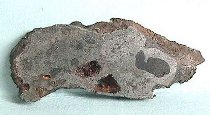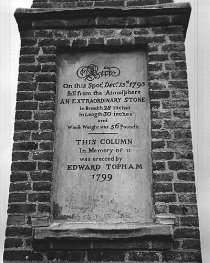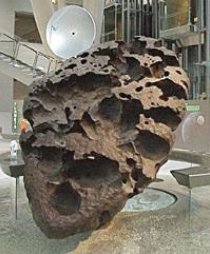The Pallas Iron and E. F. Chladni
A change in paradigms was on its way in the last decades of the 18th century. In 1772, during one of his travels through the remote areas of Siberia on behalf of czarina Catharina, the renowned German naturalist Peter Pallas examined a huge iron mass near the town of Krasnojarsk - a mass
that the Tartars said it had fallen from the sky. The 700kg iron caught the scientist's attention - it was partly covered with a black crust, and there were
many translucent olivine crystals (peridots) set in its iron matrix, something Pallas had never seen nor heard about. Unwittingly, he had discovered a new type of meteorite, a class of stony-iron meteorites that would later be named for him: the pallasites.
Pallas' subsequent report encouraged a German physicist, Ernst Florens Chladni, to publish his audacious thesis that this and other finds actually represent genuine rocks from space. In his booklet, "On the Origin of the Pallas Iron and Other Similar to it, and on Some Associated Natural Phenomena", published in 1794, he
compiled all available data on several meteorite finds and falls.
From this, he was forced to conclude that meteorites were actually responsible for the phenomena known as fireballs, and,
more importantly, that they must have their origins in outer space. His view received immediate
resistance and mockery by the scientific community. In the late 1790s, rocks from space just didn't fit into the concept of nature. However,
nature itself came to Chladni's aid in the form of two witnessed meteorite falls, making him the father of a brand-new discipline - the science of meteoritics.
>>
top... |
|

A Small Slice of the Pallas Iron


Ernst Florens Friedrich Chladni
 |
|
Wold Cottage and L'Aigle
On December 13, 1795, a stone of about 25kg was seen to fall in Wold Cottage, England, by several
eyewitnesses. The fall occurred in broad daylight, out of a clear, blue sky, refuting the most popular explanations for the formation of meteorites, such as lightning or condensation in clouds. Subsequently, the meteorite of Wold Cottage was analyzed by a young and open-minded British chemist, Edward Howard, who found it to contain grains of nickel-iron metal, similar in composition to the iron meteorites described in Chladni's book. In 1802, Howard published the results of his analysis and his conclusions regarding the Wold Cottage incident, convincing a growing number of scientists that meteorites actually represent extraterrestrial matter falling from the sky.
However, a large number of conservative scientists kept on denying the obvious facts, among them some of the most influential members of the respected French Academy of
Sciences. Their mockery and sarcasm was silenced several months after Howard's publication: on April 26, 1803, a shower of about 3,000 stones fell in broad daylight near L'Aigle, France, witnessed by countless people. This incident attracted much public attention, providing a fertile ground for further research and the young science of meteoritics. The French Minister of the Interior commissioned the young physicist Jean-Baptise Biot, a member of the French Academy of Sciences, to investigate the fall, resulting in a well-written paper that finally broke the spell. The L'Aigle fall and Biot's subsequent publication caused a scientific landslide, a change in paradigms that had been prepared in time by Chladni and Howard, establishing beyond any doubt the fact that meteorites are genuine rocks from space.
>>
top...
From the Early Days to Modern Meteoritics
The pioneering publications of Chladni, Howard, and Biot kindled a lively interest in the collection and study of meteorites. Major museums and institutions throughout the world started their own meteorite collections, some of which have become
world renown for their meteorites. Some of these include the Natural History Museum,
London, the Natural History Museum, Vienna, the Museum National d'Histoire Naturelle, Paris,
the Museum für Naturkunde, Berlin, Germany; and the American Museum of Natural History, New
York. The great advances in analytical chemistry during the middle of the 19th century,
along with the invention of the petrographic microscope, helped a new
generation of scientists to recognize the common features of certain meteorites, and led to a complex
classification system that is still valid today.
In the past 200 years, the science of meteoritics has matured to a highly interdisciplinary field.
In particular, developments during the last decades of the 20th century have revolutionized the young discipline, bringing in new fields, such as cosmochemistry, planetology, nuclear science, radio-astronomics, as well as all the data obtained by space flights and space probes. However, we are still beginning to explore our solar system, and meteorites and meteoritics can help us a lot in achieving this goal since they actually represent samples of other worlds within our solar system. Today, we have unlocked the secrets of the origin of some of the meteorites in our
collections. Isn't it great that we recognize samples of the far side of the Moon, the surface of the planet Mars,
and several asteroids in our collections - without having to invest
in very expensive space missions first? Have a look at our
Origins page to learn more about this fascinating subject and the progress of modern meteoritics.
>>
top...
|
|

The Wold Cottage Monument


Map of the L'Aigle Strewnfield


The Willamette in the AMNH

|
|